
Eucalyptus lansdowneana, commonly known as the crimson mallee or the red-flowered mallee box, is a species of slender stemmed, straggly mallee that is endemic to a restricted area of South Australia. It has rough, fibrous or flaky bark at the base, smooth, grey over creamy-white bark, lance-shaped adult leaves, flower buds in groups of seven, crimson flowers and barrel-shaped fruit.
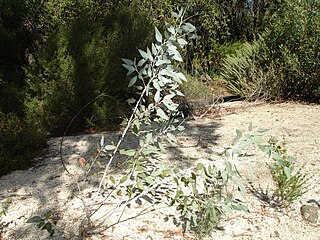
Eucalyptus cretata, commonly known as Darke Peak mallee or chalky mallee, is a species of mallee or, rarely, a small, straggly tree and is endemic to a restricted part of South Australia. It has smooth whitish and grey bark, lance-shaped adult leaves, glaucous flower buds in groups of seven, white flowers and cup-shaped to barrel-shaped or conical fruit.
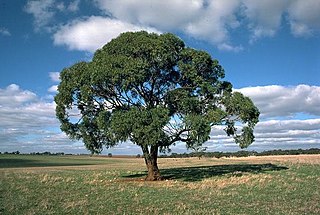
Eucalyptus odorata, commonly known as peppermint box, is a species of mallee or a small tree that is endemic to South Australia. It has rough, hard bark on the trunk and larger branches, smooth greyish bark on the thinner branches, lance-shaped adult leaves, flower buds in groups of between seven and eleven, white flowers and cylindrical or barrel-shaped fruit.
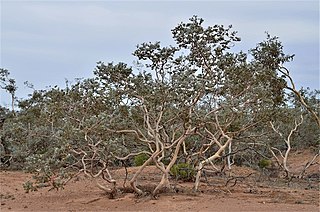
Eucalyptus gillii, known as the curly mallee, Arkaroola mallee, or silver mallee, is a species of mallee or small tree that is endemic to inland Australia. It has smooth bark, sometimes with rough bark near the base, often only juvenile, usually glaucous leaves in the crown, flower buds in groups of between seven and eleven, pale yellow flowers and barrel-shaped or shortened spherical fruit.

Eucalyptus albopurpurea, commonly known as the purple-flowered mallee box or Port Lincoln mallee, is a mallee or sometimes a tree that is endemic to South Australia. It has loose, fibrous grey-brown bark on the lower park of the trunk and smooth grey bark that is shed in strips on its upper parts. The leaves are lance-shaped to egg-shaped, the flower buds are spindle-shaped to club-shaped and the flowers are white, pink, mauve or purple. Flowering can occur in most months and the fruit are cup-shaped or barrel-shaped capsules.

Eucalyptus socialis, commonly known as the red mallee, or grey mallee, is a species of mallee that is endemic to inland Australia.

Eucalyptus eremicola, commonly known as Vokes Hill mallee, is a species of mallee that is native to South Australia and Western Australia. It has rough bark near the base, smooth bark above, linear to lance-shaped adult leaves, flower buds in groups of between nine and fifteen, white flowers and shortened spherical fruit.
Eucalyptus gypsophila, also known as the kopi mallee, is a species of mallee that is native to Western Australia and South Australia. It has rough, flaky bark on the lower part of the trunk, smooth light grey bark above, lance-shaped adult leaves, flower buds mostly in groups of between seven and eleven, creamy white flowers and conical to cylindrical fruit.

Eucalyptus mannensis, commonly known as Mann Range mallee, is a species of mallee that is native to Western Australia, South Australian and the Northern Territory. It has rough bark at the base of the trunk, smooth bark above, narrow lance-shaped adult leaves, flower buds in groups of between seven and eleven, creamy white flowers and hemispherical fruit.
Eucalyptus phenax, commonly known as green dumosa mallee or white mallee, is a species of mallee that is endemic to southern Australia. It has smooth bark, lance-shaped adult leaves, flower buds in groups of seven or nine, white flowers and cup-shaped to cylindrical fruit.

Eucalyptus rugosa, commonly known as the Kingscote mallee, is a species of mallee that is endemic to coastal areas of southern Western Australia and South Australia. It has smooth bark, lance-shaped adult leaves, flower buds in groups of between seven and thirteen, white flowers and cup-shaped, conical or hemispherical fruit.

Eucalyptus sparsa, commonly known as the northern ranges box, is a species of mallee that is endemic to inland Australia, near the border between the Northern Territory, South Australia and Western Australia border. It has smooth pale grey and brown bark, often with rough bark on the base of larger trunks, lance-shaped adult leaves, flower buds usually in groups of seven, white flowers and shortened spherical to conical fruit.
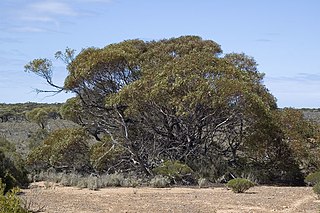
Eucalyptus yalatensis, commonly known as the Yalata mallee, is a species of mallee or a shrub that is endemic to southern Australia. It has rough, fibrous or flaky bark on the stems, smooth bark above, lance-shaped adult leaves, flower buds mostly in groups of nine, creamy white or yellowish flowers and hemispherical to shortened spherical fruit.
Eucalyptus wyolensis, commonly known as the Wyola mallee, is a species of mallee that is endemic to South Australia. It has rough bark on the base of the stems, smooth grey to brown bark above, heart-shaped to egg-shaped adult leaves arranged in opposite pairs, flower buds in groups of seven to eleven, pale yellow flowers and cup-shaped to barrel-shaped fruit.
Eucalyptus percostata, commonly known as the rib-capped mallee or Devils peak mallee, is a species of mallee that is endemic to South Australia. It has smooth bark, lance-shaped adult leaves, flower buds in groups of seven, creamy white flowers and cup-shaped to conical fruit. It is only known from a few locations in the Flinders Ranges.
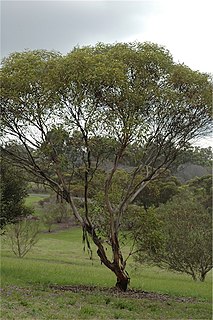
Eucalyptus calcareana, commonly known as the Nundroo mallee or Nundroo gum, is a mallee or a small tree that is endemic to the south coast of Australia. It has smooth, greyish or cream-coloured bark, lance-shaped or curved adult leaves, flower buds in groups of seven or nine, creamy-white flowers and cup-shaped to conical fruit.

Eucalyptus cyanophylla, commonly known as the Murraylands mallee, blue-leaved mallee or ghost mallee, is a species of mallee that is endemic to southern Australia. It has mostly smooth bark, greyish blue, lance-shaped or curved adult leaves, flower buds in groups of seven, white flowers and conical, cup-shaped or barrel-shaped fruit.
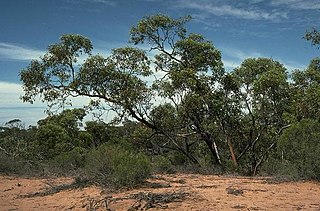
Eucalyptus yumbarrana, commonly known as the Yumbarra mallee is a species of mallee that is endemic to South Australia. It has rough, flaky bark on the lower trunk, smooth bark above, egg-shaped to lance-shaped adult leaves, flower buds in groups of seven, creamy white to yellow flowers and shortened spherical to cup-shaped fruit.

Eucalyptus canescens, commonly known as the Ooldea Range mallee or Beadell's mallee, depending on subspecies, is a species of mallee that is endemic to southern Australia. It has rough bark from the base of the trunk to the thicker branches, smooth bark on the thin branches, egg-shaped to lance-shaped adult leaves, flower buds in groups of between seven and eleven, creamy white flowers and smooth cup-shaped to conical, and sometimes ribbed fruit.
Eucalyptus minniritchi is a species of multi-stemmed, spreading mallee that is endemic to Central Australia. It has glossy, brown to grey, "minni ritchi" bark on the trunk, elliptical to egg-shaped adult leaves, flower buds mostly in groups of seven, pale creamy yellow flowers and conical to hemispherical fruit.

















